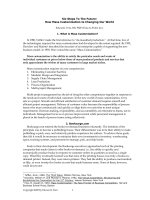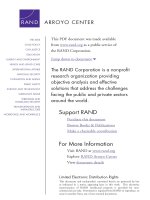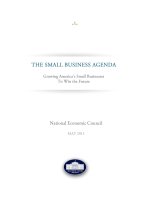HR TRENDING TO THE FUTURE Jo Pryce FINAL
Bạn đang xem bản rút gọn của tài liệu. Xem và tải ngay bản đầy đủ của tài liệu tại đây (2.73 MB, 64 trang )
HR Trending
into the Future
Dr Josephine Pryce
May 2015
Overview . . .
• The new world of work
• Trends that are shaping HR:
–
–
–
–
SHRM
ACCENTURE
Gibson, Ziskin and Bourdreau
Josh Bersin
• HR Readiness
The new world of work . . .
• “Whether you’re ready for it or not, the new
way of work is multi-generational, multigeographical, location agnostic, and device
dependent” (Holland et al., 2015, p3).
• “The past decade has seen a seismic shift in the
employment landscape in Australia, not only in
the amount and type of changes workers can
expect to make during their lives but also in the
type of roles people are choosing to explore…”
(Emerson, 2013, p.2)
Trends that are shaping HR:
The findings from SHRM . . .
20 years from now . . .
• “a mere 20 years ago, not many people would
have been able to predict the sheer scale of
technology’s impact on the nature of work and
the culture of the workplace”.
• From this point it can be asked:
“What will the world of work look like
20 years from now?”
>>Society for Human Resource Management (SHRM)<<
[ />
The Research
• In 2013, SHRM sponsored research conducted by
the Economist Intelligence Unit (EIU).
• The Economist Intelligence Unit ran a survey that
involved 636 middle and senior executives and
the report presented the HR challenges that
emerged from the findings.
• These included . . .
The Findings – Challenges facing Organisations
The Findings – HR Challenges
• THE NATURE OF THE WORKER
1. Adapting to a rapidly changing worker profile
2. Understanding the subtleties of workers’ qualifications
3. Retaining and engaging a changing workforce
• THE NATURE OF THE WORK
4. Aligning technology best practices to global
management strategy
5. Managing the risks of a global operation
• CONFLICTING EXPECTATIONS OF WORKERS AND
THE WORKPLACE
6. Hiring and retaining talent while lowering labour costs
7. Winning the war for talent
Some key findings . . .
2. Understanding the subtleties of workers’ qualifications
2. Understanding the subtleties of workers’ qualifications
2. Understanding the subtleties of workers’ qualifications
3. Retaining and engaging a changing workforce
3. Retaining and engaging a changing workforce
3. Retaining and engaging a changing workforce
4. Aligning technology best practices
to global management strategy
5. Managing the risks of a global operation
Another SHRM report . . .
Over the next 10 years, what do you think will be the three biggest
challenges facing HR executives at your organization?
Note: Percentages do not total 100% due to multiple response options. Respondents who answered “don’t know” were
excluded from this analysis.
Over the next 10 years, what do you think will be
the biggest investment challenge facing organizations?
/>
Over the next 10 years, which of the following tactics do you believe will be
most effective in attracting, retaining and rewarding the best employees in your
organization?
Note: Percentages do not total 100% due to multiple response options. An asterisk (*) indicates option was not included on 2010 survey.
Challenges Facing HR Over the Next 10 Years ©SHRM 2012
23
Ten years from now, which of the following competencies do
you see being most critical for the HR professional?
Note: n = 472. Percentages do not total 100% due to multiple response options.
Challenges Facing HR Over the Next 10 Years ©SHRM 2012
24
Key Findings
• What bodies of knowledge do HR professionals rate as
being the most important in 10 years?
– The four bodies of knowledge that were rated as most
important were:
• strategic business management
• talent management
• change management
• workforce planning and employment
[see over]
/>Challenges Facing HR Over the Next 10 Years ©SHRM 2012
25









